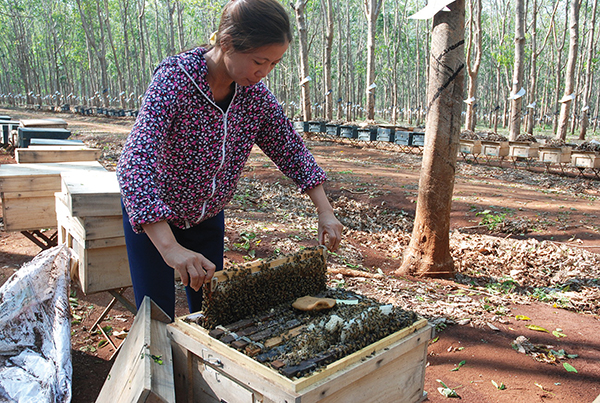Around March every year, keepers from across the country send their swarms of bees to the Central Highlands for the insects to suck the best nectar there and produce the finest-quality honey.
Such Central Highlands provinces as Kon Tum, Gia Lai, and Dak Lak are home to boundless fields of coffee and rubber plants.
The coffee fields bloom around March and April each year, which makes it an ideal time for bees to suck the nectar from the blossoms.
The nectar is believed by bee keepers to be unrivalled in the country and help their insects yield the finest honey.
Some thousands of bee swarms are packed in tightly shut wooden containers and transported by truck for up to some hundreds of kilometers to the nectar “mecca.”
Many bee farmers come from as far as Nghe An, Ha Tinh and Quang Ngai Provinces in the central region and Binh Duong Province and Can Tho City in the south.
The rubber forests, which nestle in Ia Chim Ward, some 25 kilometers from the heart of Kon Tum City, seemed to be jerked back to life after a shower.
The city is the capital of Kon Tum Province.
Nguyen Thi Thao, and her husband, Dinh Khac Nghi, were delighted at their most-awaited moment, when young leaves begin to sprout and their leaf stems produce the largest quantity of nectar.
The nectar “strings” are hardly visible to bare eyes, but are irresistibly tempting to swarms of bees, which are particularly quick to pick up the scents.
“During years when severe droughts raged, leaving plants withering and flowers’ quality dropping, I still brought my swarms here, as the area has become my home-sweet-home,” Nghi said.
As bees are a highly sensitive species, it takes great care during the transport and setting up his camp at the rubber forest, he noted.
“The insects must be moved during the night while they are asleep and reach the new camp early the following morning. After some weeks of relaxation and adaptation to the new environs, the bees will begin to yield honey,” Nghi divulged.

A migrant bee keeper is delighted at his first honey harvest this year's season. Photo: Tuoi Tre
Nguyen Van Thiep and his wife, Dang Thi Thanh, took some hundred containers of bees all the way from their farm in the central province of Quang Ngai to the rubber forest in Kon Tum City.
“We are by and large on the move to any locality where flowers bloom. The Central Highlands region is our miss-not location every year, as the quantity and quality of nectar here are unrivalled compared to elsewhere,” Thanh explained.
During this peak season, most rubber and coffee forests are divided into “zones” and packed with bee keepers, their camps, and hundreds of beehives, according to Thai Khac Tuan, manager of the Ia Chim Rubber Farm.
Phan Ba Ngoc, a bee keeper, and his wife have taken their swarms to the coffee plant farms in Kon Tum since February.
His 300 hives have yielded up to almost two metric tons of honeybees.
“Nowhere else in the country is as serene, safe and nourishing for the insects as it is in the Central Highlands. If all goes well, I’ll harvest dozens of metric tons of honey and earn some hundreds of millions of dong [VND1 million ~ US$47] after each season,” Ngoc revealed.
Tu Hoi, another migrant bee keeper, said he has all the flowering rubber and coffee farms across the Central Highlands in the palm of his hand.

A makeshift tent erected by a migrant bee keeper, with the beehive containers nearby. Photo: Tuoi Tre
A number of bee keepers also go to great lengths to take their swarms to the Ngoc Linh Mountain, a resplendent mountain best known for its rich reserve of medicinal herbs and ginseng.
The mountain stands in Dak Glei District in Kon Tum Province.
The areas in the proximity of the mountain are overgrown with wild flowers, which are rich in nectar content.
Bee keepers revealed that honey produced from wild flower nectar boasts a gorgeous texture and color, and is incomparably fragrant.
This type of honey thus fetches good prices on the local market, they added.
However, few bee farmers have taken up the practice so far, which involves a number of risks, including the bees’ inability to adapt to the alien habitat and their susceptibility to getting killed by larger breeds of forest bees.
Like us on Facebook or follow us on Twitter to get the latest news about Vietnam!






















































